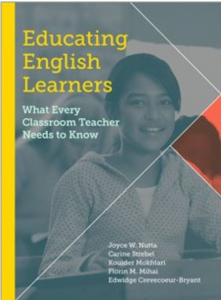Educating English Learners
English learners are not a homogenous group, and the challenges they face vary tremendously. Below, you will find a list of link compiled by Dr. Nutta and her colleagues to help pre-service and in-service teachers understand the needs of English learners in their classrooms. Following the structure of the book Educating English Learners, What Every Classroom Teacher Needs to Know, the following resources have been divided into two parts. The first one focuses on the teaching of academic subjects to English learners and the second on the Teaching of Language Arts & Literacy.
Teaching Academic Subjects to English Learners
Because English learners are not a homogenous group, our team compiled resources covering different English learners’ background.
Haitian Students in US Schools
Mexican Students in US Schools
Arabic-Speaking Students in US Schools
Puerto Rican and Spanish-Speaking Caribbean Students in US English-Speaking Schools
The links below provide more information on major topics addressed in the Introduction chapter of Educating English Learners, What Every Classroom Teacher Needs to Know, with links to freely available resources that can be used for further study or to activities that can be viewed or conducted in classes or workshops. At the bottom of this page, we share links to online resources for classroom use with English learners K-12.
- Basic Interpersonal Communicative Skills (BICS) vs. Cognitive Academic Language Proficiency (CALP)
Description and examples of BICS and CALP, and how to determine where tasks fall on the BICS/CALP continua. - L’Arancia (Procedure) Video Workshop for Pre-Service Teachers
- Creating Classroom Procedures and Routines
Example of a Lesson Plan Before and After Applying the Academic Subjects Protocol
Teaching Mathematics to English Learners
Table Turner Experience–Mathematics
Resources for Classroom Use
Teaching Language Arts and Literacy to English Learners
Assessment of English Proficiency
Comparing First and Second Language Acquisition
Historical Language Teaching Methodologies
Instructed Second Language Acquisition
Language Arts Instruction for English Learners
Language Arts Lesson Plans Before and After Application of the Language Arts Protocol
Literacy Development for Adolescent English Learners
Literacy Development for English Learners with Low Level Literacy in the L1
Dual Language Learners in Early Childhood
Integrated Language Arts (Oral Language and Literacy) Instruction for Primary Grades
Integrated Language Arts Instruction for Intermediate Grades
Literacy Instruction for Intermediate Grades
Oral Language Instruction for Intermediate Grades
Integrated Language Arts Instruction for Middle School
Literacy Instruction for Middle School
Oral Language Instruction for Middle School
Integrated Language Arts Instruction for High School
Literacy Instruction for High School
Oral Language Instruction for High School

In a hurry? No problem.
Use the search bar below to find what you are looking for. Otherwise, keep scrolling!
Educating English Learners
What Every Classroom Teacher Needs to Know

In Educating English Learners, Joyce W. Nutta and her colleagues offer practical tools for helping schools and teachers successfully integrate English learners into mainstream classrooms. Drawing on the One Plus model presented in their award-winning book, Preparing Every Teacher to Reach English Learners, the authors now turn their attention to the needs of K–12 teachers who typically have two or three English learners in their classrooms.
Woven throughout the book are the stories of Gero, Edith, Tasir, and Edgar, four case study students of different ages, backgrounds, and levels of English proficiency. The authors show how the protocols they provide can be applied to adapt sample lessons for students like these, across a range of grade levels, subject areas, and pedagogical approaches. Finally, the authors show how the system can be applied school-wide for a collaborative approach to meeting English learners’ needs.
Part I – Teaching Academic Subjects to English Learners
Each chapter webpage provides links to pages for every topic listed. On the topic page, a brief narrative summary provides an overview and then major subtopics are listed as headings, with links to outside resources.
In the Introduction you will meet our 4 English learners, Gero, Edith, Edgar, and Tasir, and will learn about the issues that affect their performance at school. These include:
- Types of English learners—newcomers, U.S. born, long term
- General stages of English proficiency—silent period to fluency
- Basic Interpersonal Communication Skills (BICS, or social language) and Cognitive Academic Language Development (CALP, or academic language)
- Cultural adjustment
- Individual characteristics that affect English language development—motivation, attitude, age
- The role of input, interaction, and output in second language acquisition
- Effect of grade level on language demands of academic subject instruction
- Effect of prior knowledge of the subject and first language literacy on academic subject achievement
- Assessing English learners’ knowledge of academic subjects
- Assessing the gap between grade-level academic subject instruction and English proficiency—examples from grades K, 4, 7, and 10
- Protocol for adapting mainstream academic subject instruction to an English learner’s proficiency level—the Academic Subjects Protocol
- Support strategies for providing nonverbal and verbal support in curriculum, instruction, and assessment of academic subjects
— Text simplification and elaboration
— Leveled questions
— Sentence frames
— Word banks and glossaries
- Nature of social studies texts and vocabulary
- Specific challenges English learners face in social studies
- Developing English learners’ academic vocabulary in social studies
- Kindergarten social studies lesson before and after application of the Academic Subjects Protocol (lesson analysis and adaptations) for English learners
- Nature of science discourse and text
- Science knowledge and habits of mind challenges for English learners
- Developing English learners’ academic vocabulary in science
- Promoting English learners’ language interaction in science instruction
- Fourth grade science lesson before and after application of the Academic Subjects Protocol (lesson analysis and adaptations) for English learners
- Nature of communication in project-based learning
- Using technology in project-based learning to support English learners
- Seventh grade environmental studies lesson before and after application of the Academic Subjects Protocol (lesson analysis and adaptations) for English learners
- Nature of communication in mathematics
- Mathematics vocabulary
- Challenges of teaching mathematics to English learners—word and other “problems”
- Tenth grade mathematics lesson before and after application of the Academic Subjects Protocol (lesson analysis and adaptations) for English learners
Puerto Rican and Spanish-Speaking Caribbean Students in US English-Speaking Schools
Part II – Teaching Language Arts and Literacy to English Learners
Each chapter webpage provides links to pages for every topic listed. On the topic page, a brief narrative summary provides an overview and then major subtopics are listed as headings with links to outside resources.
- Language and communication
o Learning through language, learning language, and learning about language - Naturalistic and instructed second language acquisition
o What they look and sound like
o Instructional conversations - When and why instructed second language acquisition is necessary
o Focus on form and formS
o Processability theory
o Fossilization/stabilization - Individual factors and second language acquisition
o First language influence
o Age
o Learner language/interlanguage - Comparing mainstream and English language development/English as a second language (ELD/ESL) environments
- Language form and structure in second language literacy
- Learning to read in English—native and non-native speaker comparison
- Role of vocabulary, word forms, and sentence structure in second language reading
- Describing and measuring English proficiency
o WIDA/TESOL levels of proficiency
o WIDA Can Do Descriptors - Targeting language arts and literacy instruction to English learners’ WIDA levels of proficiency
- Assessing the gap between Common Core State Standards grade-level language arts and literacy instruction and an EL’s WIDA proficiency level
- What scaffolding English learners’ language arts and literacy instruction means and how it is done
o Pitch, Pace, Portion, and Perspective/Point - Use of technology for scaffolding language arts and literacy instruction
- Protocol for scaffolding language arts and literacy instruction specific to an English learner’s WIDA proficiency level—The Language Arts Protocol
- Comparing Common Core State Standards grade-level expectations for language and literacy in kindergarten to the proficiency of a WIDA Level 1 English learner
o Analyzing language samples - Research on teaching language and literacy to English learners in primary grades
o National Literacy Panel
o Role of oral proficiency
o Transfer from the first language - Kindergarten writing lesson before and after application of the Language Arts Protocol (lesson analysis and adaptations) for WIDA Level 1 English learner
- Comparing Common Core State Standards grade-level expectations for language and literacy in fourth grade to the proficiency of a WIDA Level 1 English learner
o Analyzing language samples - Research on teaching language and literacy to English learners in intermediate grades
o Reading comprehension - Compensatory theory of second language reading
o Role of oral proficiency
o Transfer from the first language - Fourth grade reading lesson (prefix, root, suffix) before and after application of the Language Arts Protocol (lesson analysis and adaptations) for WIDA Level 1 English learner
- Comparing Common Core State Standards grade-level expectations for language and literacy in seventh grade to the proficiency of a WIDA Level 5 English learner
o Analyzing language samples - Research on teaching language and literacy to English learners in middle school
o First language influences
o Contrasts in first and second language writing
o Transfers of literacy skills and strategies
o Error correction in writing - Seventh grade writing lesson before and after application of the Language Arts Protocol (lesson analysis and adaptations) for WIDA Level 5 English learner
- Comparing Common Core State Standards grade-level expectations for language and literacy in tenth grade to the proficiency of a WIDA Level 3 English learner
o Analyzing language samples - Research on teaching language and literacy to English learners in high school
o First language influence
o Oral proficiency
o Explicit instruction of grammar - Tenth grade English language development lesson (integrating reading and collaborative discussions) for a WIDA Level 3 English learner
- Roles of different school professionals and what they should know and be able to do to support English learners
- School wide collaboration for English learner success
o Continuum of systemic instructional support for English learners
o Professional learning using this book
o The who, what, why, when, where and how to support English learners’ success at your school - Encouragement to get started
© 2022 All Rights Reserved.
